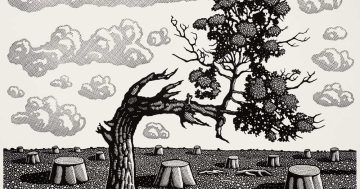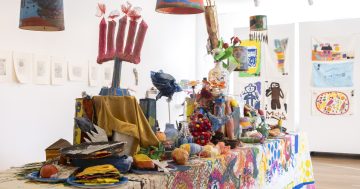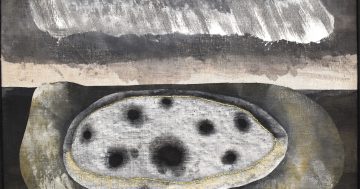
Tanya Myshkin, Jonah, 1999, wood engraving on red gum, eucalyptus camaldulensis, printed on Arches 8, 56 cm x 78 cm. Photo: Supplied.
Tanya Myshkin is certainly not a household name, even in art circles.
Her imagery is difficult, confronting and laced with a degree of the gothic grotesque. The prevailing blackness in the imagery is matched by the awkward intricacy of her technique and her favourite chosen medium of wood engraving.
Most associate wood engraving, one of the most painstaking printmaking techniques, with tiny postage stamp-size prints that are very finely worked and frequently imbued with a sense of nostalgic intimacy. Myshkin, for her wood engravings, takes huge rings of red gum or yellow box and then carves her designs into the wood over a period of months, sometimes years, with tortured and contorted figures squeezed into the spaces. They are visually amazing pieces – a collaboration with the medium – as the gum cracks and develops its own patina, this is absorbed into the fabric of the design.
The huge carved blocks are too fragile to be printed by a press and therefore are inked, covered with a sheet of French 100 per cent cotton Arches paper, and then rubbed on the back to transfer the design.
The technique is demanding, and after many months of work, only a few prints – a maximum of five – can be printed from the matrix before it loses definition. Her giant wood engravings in this exhibition, including The real soul of Loulou, 1994, Anxiety observing despair, 1994, and Jonah, 1999, also all included in the collection of the National Gallery of Australia, are some of the most amazing wood engravings that you are ever likely to encounter.

Tanya Myshkin, Two dead rats, 1991, drypoint on copper, printed on Hahnemuller paper 53 cm x 36 cm. Photo: Supplied.
Myshkin, who was born in Adelaide and trained at the Canberra School of Art in its heyday under Gillian Mann, Jörg Schmeisser and Petr Herel, lived for many years in Melbourne before settling in Queanbeyan. Aged in her early 60s, this exhibition represents a very selective survey of her graphic work from 1987 to 2023. She is an artist of gothic noir, and an existential darkness permeates much of her art.
She possesses an obsessive and penetrating eye that is constantly alert to the casualties that we encounter and choose to ignore in our daily life. There is a beautiful series of drypoints from 1990 to 1993 observing the shrivelled remains of dead mice and rats. These are deeply moving, anthropomorphic images, where these beautifully and lovingly observed creatures comment on the existence and then the non-existence of all living beings.

Tanya Myshkin, The real soul of Loulou, 1994, wood engraving on red gum, printed on Arches 88, 76 cm x 108 cm. Photo: Supplied.
Myshkin is a very strong draughtsman, possibly in the tradition of someone like the Austrian expressionist Egon Schiele with his love for intensity and raw sexuality. Her line does not simply describe or articulate a figure or surface but interprets it and gives it a living existence. In such art, it is normal to see a personal and diaristic dimension; in other words, most of Myshkin’s works, in one way or another, could be viewed as a form of self-portraiture. She is relating to her audience things that she has observed, experienced, thought of, or interpreted through her broad frame of literary reference.
However, what saves her art from becoming a self-indulgent fantasy is how it affects all of her viewers and makes them question their environment and their own place in the world. It is a dark and disturbing exhibition that is also visually exciting and quite profound.

Tanya Myshkin, Anxiety observing despair, 1995, wood engraving on yellow box, printed on Arches 88, 108 cm x 76 cm. Photo: Supplied.
Although Myshkin is represented in some major public art collections in Australia and Europe, she does not belong to the species of ego-driven, self-promoting artists. She has worked under the radar of the art publicity machines for much of her four decades of consistent art practice. The exhibition at Megalo is a rare opportunity to view the work of a significant local artist whose artistic vision is authentic and unique.
Tanya Myshkin, Wood engravings and drypoints, is now exhibiting at the Megalo Print Studio and Gallery, 21 Wentworth Ave, Kingston, until 29 June, Tuesday to Saturday, from 9:30 am to 5 pm.





















